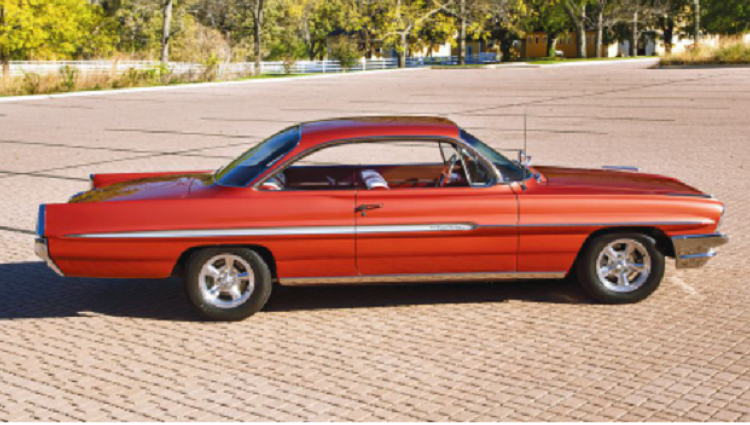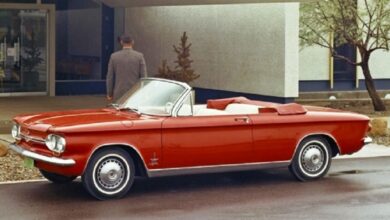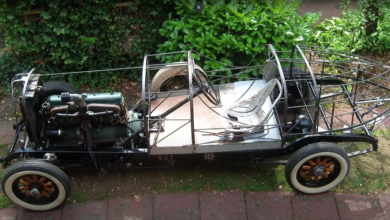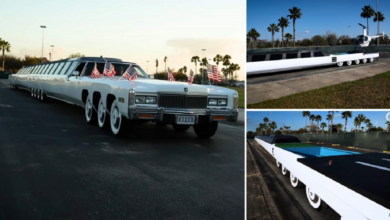A ’61 Pontiac Ventura That Merges Period Style And Power With Modern Enhancements.
To simply state that Peru, Illinois, resident Bill Sherman is a “gearhead” does little justice to the vast performance talent the self-confessed farm boy possesses. His mechanical prowess was earned early, starting in his teenage years.
“The whole thing started off in the Fifties,” Bill explains. “My father was into motorcycles, and cars to a lesser extent. His interests wore off on me and when I was 15, I built my first car. It was a 1934 Ford coupe, and I installed a bored-and-stroked flathead V-8, all done on the family farm in an old dirt-floor shed. The Ford wasn’t a show car, but I sure had a lot of fun in it. I belonged to a local car club; they broke their age rules and allowed me to join. Believe it or not, I drove the car before I had a license. I was only supposed to go on the country roads, but I bent the rules a little bit from time to time.”
Once he’d been behind the wheel, it didn’t take long for young Bill to get a taste for speed and competition. “A year after I got the Ford on the road, I started playing around on a small Harley-Davidson on the farm. I then began dirt track racing it as an amateur at the local tracks. Before long, I was one of the professional dirt trackers, racing at a well-known place called Santa Fe Speedway. I was still racing the dirt tracks when I was a senior in high school, by which time I was working two jobs to pay for the motorcycle and the Corvette I had just purchased. Even though I was only 17, I felt like I was 25,” Bill says.
It was right about this time that Bill, who had become a regular attendee at the famed Oswego Dragstrip, became enamored with Arnie Beswick’s 1961 Pontiac “bubbletop” Ventura called Passionate Poncho.
“My father bought a ’59 Pontiac when they first came out, and a guy down the road ended up with a ’59 Tri-Power Pontiac that he put a rake on and added Moon hubcaps, so the brand had appealed to me anyway. But standing near the line when Arnie lined up with that bubbletop, and watching a hint of daylight appear under the front end when he launched, that was the kicker for me. I thought to myself, ‘Someday I’m going to have one of those.’ At the time I didn’t realize I was going to have to wait 50 years.”
That’s because Bill’s path had a few twists and turns. First, his dirt track racing career came to a crashing halt, quite literally. While recuperating, the 19-year-old newlywed calculated that starting a fresh vocation as an apprentice tool and die maker at Caterpillar was the responsible thing to do. Not wanting to give up his passion, however, Bill launched a career as a motorcycle drag racer on a Triumph, and his prior experience sent him on a collision course with the record books. During the 1965 season, Bill landed a rare, special-order Harley-Davidson XLRTT and went undefeated. He also won the Nationals in Rockford, Illinois. He was just 21.
Over time, Bill returned to farming, began raising a family, and eventually retired from competition. He was also fortunate to collect parts of his racing past, which joined his supercharged Hemi-powered 1932 Ford and big-block-Chevy 1933 Ford three-window coupe in the garage. But his passion for Pontiacs and performance never wavered, and in 2011, an opportunity to combine both presented itself.
“I was told about a 1961 Pontiac Ventura that someone had begun work on. It was originally a California car, built at the old South Gate plant, that somehow ended up in the Midwest, but that’s all I really knew. There was a lot done to the Ventura—it was well on its way, and I just couldn’t pass it up. I thought, ‘If I’m going to own one of these, I better get with it,’ so I bought it with a vision in mind. Rather than follow the lead and build another Pro Touring car, I wanted a combination of contemporary restomod traits with in-period alterations and originality. I’m not sure what you’d really call it,” Bill remarks.
To start, the body had already been completed by Roger Ferris, of Showcar Specialist in St. Louis, Missouri, refinished in Dawnfire Mist using a modern basecoat/clearcoat system, and the chassis had been prepped for updated suspension components. Meanwhile, much of the original Ventura-specific tri-color Morrokide interior had been detailed back to life, prompting Bill to consider that the car’s care on the West Coast must have been meticulous. The original engine and transmission were missing, though, which was hardly a concern for Bill and his vision.
Rather than install a new crate engine, a Pontiac 400 was bored to 406 cubic inches, then topped with a Tri-Power setup on an Offenhauser aluminum intake manifold. The combination makes 368 hp and 433 lb-ft of torque.
“Rather than go with another LS engine, I sent a later 400-cu.in. Pontiac engine to Gary Duckworth Racing Engines down in Maryville, Illinois. He’s an ex-Pro Stock racer. He bored it out .030, which pushed the displacement to 406 cubes.” Gary then installed a Comp Cams hydraulic roller camshaft, along with Jahns forged pistons with refurbished stock Pontiac connecting rods. Similarly, a stock Pontiac crankshaft was used. The internals were capped by a pair of 421-cu.in. Pontiac cylinder heads (casting #716) from the 1963 model year, fitted with Comp Cams valve springs, along with Offenhauser ribbed rocker-arm covers and an Offenhauser aluminum Tri-Power intake manifold wearing a correct trio of Rochester 2-GC two-barrel carburetors. Another stock component found on the engine is the distributor. A Griffin aluminum radiator was then specified to assist with cooling.
The exhaust system was custom made, starting with stainless-steel headers feeding into dual 3-inch oval stainless-steel pipes, tucked against the chassis, accommodated by the fabrication of a custom crossmember. As Bill explains, “I didn’t want the system hanging down below the car like an afterthought; I wanted it tucked up tight like a factory setup.”
When the engine was completed, but prior to putting it back in the car, Bill wanted to see what it was capable of. “Gary ran it on the dyno and it pulled around 368 hp, which is period output,” Bill says, referring to respectable figures from the days when this Pontiac was young. “That’s exactly what I was looking for.”
Next, instead of using a stock Borg-Warner T-10 four-speed, Bill chose a Richmond Gear close-ratio Super T-10. Meanwhile, in the rear, he selected a Currie Ford-style 9-inch differential, equipped with limited slip and a 3.50:1 gearset. According to Bill, though, “We had to customize the rear end to get it to fit with the Radir wheels and Pro Street tires. Cutting the frame or the body was not even a consideration. It’s tight—maybe a half-inch of clearance in spots—but it works for me.”
Which bring us to the suspension of this period Pontiac build. When it was launched, the aftermarket support for this chassis was minimal and swapping in parts designed for a same-year Chevy was impractical because of the frame design. “Chevy used an X-frame, while Pontiac had a perimeter design,” Bill explains. “So, Roger and I reached out to Mark Linn, who was able to masterfully fabricate front tubular upper and lower control arms, along with an anti-roll bar. He did the same for the rear suspension. We then replaced the original coil springs with QA1 coilover shocks at all four corners. I wanted a period rake, of course, so 2-inch drop spindles were installed. Most guys will raise the back end; it’s easier and you can fit everything with minimal effort, but that’s cheating, and it doesn’t look right,” Bill says.
Rounding out the chassis were a set of late-model GM drilled-and-slotted rotors, along with corresponding calipers, and a quick-ratio steering box from Detroit Speed & Engineering. A final touch was the aforementioned Radir “round spoke” wheels, measuring 15 x 6 inches up front and mounting 225/75R15 radials, while the 15 x 8 wheels in the rear handle those big 28 x 9.6 Hoosiers.
A shot of the Ventura’s underside reveals its modified suspension components and dual-exhaust system. The car’s control arms and anti-roll bars were custom fabricated, as was the 3-inch stainless steel exhaust. Coilovers handle the suspension chores at all four corners while Radir wheels add a period touch and provide airflow to drilled rotors.
That’s not to say the Pontiac was completed. Other touches included stainless-steel lines and fasteners throughout. Even the body plugs are stainless. And while the interior was essentially done when the project began, three fine detail changes were administered: The solid portions of the original steering wheel and the metal portions of the dash panel were painted to match the exterior Dawnfire Mist, while the original 120-mph speedometer plate was replaced by a very stock-looking 150-mph unit. “Most people don’t see that when they look inside the car,” Bill reports, adding that “It looks factory in there. We even reinstalled the original 1961 bench-seat-style ‘spaghetti shifter’ with its tiny white knob. Most guys would have thrown it out and put in a big Hurst shifter.”
Two years after purchasing the partially completed Ventura, Bill’s long-harbored dream of owning and driving his own coveted example was ready for the road, and a few shows along the way.
One of the most notable events Bill attended was the 2017 Street Rod Nationals, held in Louisville, Kentucky. At the end of the show, Bill’s Pontiac landed a coveted Top 100 prize, out of a contingent of 10,300 vehicles. But while shows and cruise-ins help showcase the tremendous work done to the Pontiac, Bill—who, as of this writing is scheduled to be inducted into the Hot Shoe Hall of Fame—still likes a spirited excursion, helping explain his choice in tires.
“This wasn’t built as a race car; it was built as a driving car with period-correct horsepower. That’s why I went with radials. I was able to keep the subtle big-and-little look, but not chase it all over the road. When I take this thing out, even though I don’t go that far, I like to hit the corners with it. It’s not strictly a straight-line car. This Pontiac is built to corner, too. I’m not saying it will outhandle a new Corvette, but for a heavy full-size car, it does really well.”











